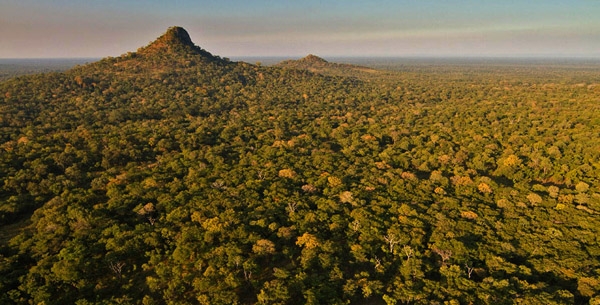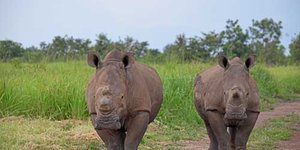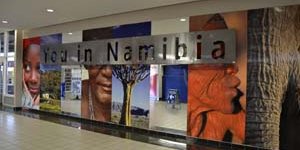Like this article?
Go on, give it a kudu!

Published on July 12 2015
Written by:
Pip Strickland
1838 views
Despite almost two decades of civil war within Mozambique, with much of its infrastructure destroyed and wildlife poached for its lucrative ivory and bushmeat, Gorongosa National Park, a former battle ground at the southern end of the Great African Rift Valley, is now well on the road to recovery. It is spread over 4,000 square kilometres, rising from the valley floor to the surrounding plateaus, and its ecosystems include grasslands, savannah, seasonal flooded pans, montane and miombo forests, as well as limestone gorges swathed in rainforest. The rivers flowing into Lake Urema are the lifeblood of the park and its resident wildlife, flooding the plains and valley during the wet season and contracting again during the dry. This constant process creates a patchwork of niche habitats, resulting in the incredible diversity of wildlife that Gorongosa supports.
The slopes of Mount Gorongosa support more than 2,000 people whose relatively sustainable farming practices largely maintained the ecological systems here, although widespread habitat destruction and poaching during the civil war severely threatened the park’s wildlife. In the post-war years the park suffered even more catastrophic poaching as the country struggled for stability, but wildlife numbers have now been slowly restored, infrastructure rebuilt, and peace returned. Large game such as elephant and buffalo were relocated from next door South Africa, followed by eland and zebra, and today the park boasts 122 mammals, 34 reptiles, 43 amphibians and almost 400 bird species. Gorongosa’s rich biodiversity includes species found nowhere else in the world and a complex, interdependent ecosystem that make its conservation so vital.
The restoration of Gorongosa National Park following the civil war was initiated by the United States not-for-profit organisation, the Carr Foundation (headed by American philanthropist, Greg Carr), in conjunction with the Government of Mozambique. The aim is not only to restore the infrastructure, habitats and wildlife numbers of the park, but also develop a sustainable ecotourism industry that provides long-term benefits to the local community. The park’s boundaries have been expanded to include Mount Gorongosa whose lofty heights capture the life-sustaining rain which drains into the surrounding rivers and across the valley floor. Nurseries have been established to help reforest the mountain’s slopes, and both schools and health clinics have been built to improve the lives of those who live there.
While much of the park’s infrastructure was damaged during the war, the original headquarters at Chitengo Camp in the south remain, including 18 air-conditioned cabanas, a shaded camp ground, an on-site restaurant and a swimming pool - ideal for an after safari swim. A scientific research and education centre has also been established to educate visitors about the importance of the park’s biodiversity and its ongoing preservation. Guided game drives and village visits can all be organised from Chitengo and there are plans to expand the activity program as tourists slowly return to the park.
Mozambique officially experiences a wet and dry season, with the later extending from around mid-April through to mid-December. Currently the park is only open during this long, dry period, but wet season safaris are gradually being trialled during the shoulder months to take advantage of the birdlife (and see if vehicles can handle the muddy conditions).
Visiting Gorongosa is not only an impressive wildlife spotting experience, it is also a model of what successful conservation projects can achieve. While the park has made a strong recovery and is on the road to again be one of Southern Africa’s premier wildlife viewing destinations, the past is not forgotten and a bullet-pocked concrete slab serves as a war memorial at Chitengo Camp, a constant reminder of what this park, and its resident wildlife, have endured.
gorongosa.org
Has been on: 13 safaris
I am definitely an adventure traveller. I like to trek mountains, dive reefs and explore cultures in depth. I like to camp out in the wilds under the stars or live amongst the local communities and absorb as much as possible. I think if you open your heart and mind when travelling the rewards are endless.
© Your African Safari Ltd, All rights reserved.
Your African Safari is a safari-planning and safari review site. It was created to help support a healthy African wildlife population. All reviews are vetted before being approved and only ethical tours are published

Garamba National Park—an anchor of hope in the Democratic Republic of Congo
Published on January 09 2025
By: R.W.

Namibia imposes new visa requirements
Published on July 25 2024
By: yourafricansafari.com

Do I really need travel insurance or travel protection for my safari?
Published on July 30 2024
By: yourafricansafari.com